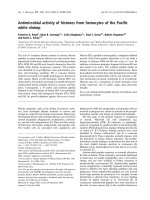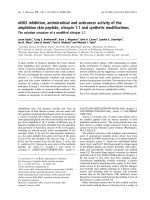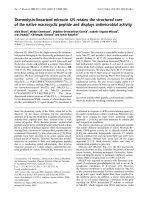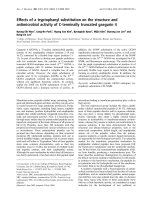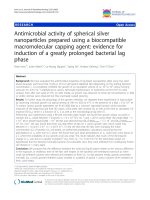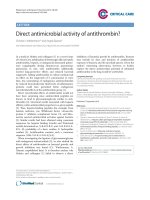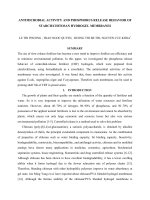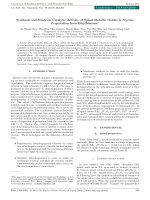Antimicrobial activity of Ethanolic and Methanolic extract of Artocarpus Lakoocha Wall. Ex Roxb. (Moraceae) against five different oral bacterial strains
Bạn đang xem bản rút gọn của tài liệu. Xem và tải ngay bản đầy đủ của tài liệu tại đây (153.27 KB, 5 trang )
Int.J.Curr.Microbiol.App.Sci (2019) 8(3): 1321-1325
International Journal of Current Microbiology and Applied Sciences
ISSN: 2319-7706 Volume 8 Number 03 (2019)
Journal homepage:
Original Research Article
/>
Antimicrobial Activity of Ethanolic and Methanolic Extract of
Artocarpus lakoocha Wall. Ex Roxb. (Moraceae) against Five Different Oral
Bacterial Strains
P.C. Nath* and Sarmila Boruah
Institutional Level Biotech Hub, Sibsagar College Joysagar, Sivasagar, Assam 785665, India
*Corresponding author
ABSTRACT
Keywords
Antimicrobial,
Artocarpus
lakoocha, Oral
bacteria, Zone of
inhibition
Article Info
Accepted:
12 February 2019
Available Online:
10 March 2019
Antimicrobial activity of ethanolic and methanolic extract of Artocarpus
lakoocha Wall. ex Roxb. bark were evaluated against five oral inhabiting
bacteria i.e., Escherichia coli (ATCC 8739), Streptococcus mutans (ATCC
25175), Streptococcus sanguinis (ATCC 10556), Porphyromonas gingivalis
(ATCC 33277) and Fusobacterium nucleatum (ATCC 25586) at different
concentration by using agar well diffusion method. The test extract was
found to be bacteriostatic in action, thus can be used as a source of
antibiotic substances for drug development and in the control of these
bacterial infections.
Introduction
Artocarpus lakoocha Wall. ex Roxb.
(Moraceae) is a tropical deciduous plant
common in Northeastern India as well as in all
South East Asian nations. The plant is
generally used for its durable wood for
furniture and house building. The seeds are
edible by roasting and the leaves are good
fodder for cattle. Besides, the tender bark of
the tree is used by several communities for
masticatory purpose together with betel nut
(Borthakur, 1981). The seeds and bark of the
plant is used to treat stomach and liver
diseases. The bark is also used as astringent
that shrinks or constricts body tissues (Perry,
1980). The fruits are the source of vitamins
and antioxidants like vitamin C and betacarotene. In addition to these lots of minerals
such as zinc, copper, manganese and iron are
present which acts as antioxidant (Jahan et al.,
2011). World Health Organization has
reported that about 80% of the world depends
on traditional herbal medicine for their
primary health care (Vijayan et al., 2007). The
different parts and chemical constituents of
1321
Int.J.Curr.Microbiol.App.Sci (2019) 8(3): 1321-1325
this plant can be the possible starting points
for new drugs (Tijani et al., 2008).
Materials and Methods
A number of studies show that using up of
different tropical fruit species had helped to
curb the danger of no-communicable diseases
like diabetes, cancer, coronary heart disease,
neurodegenerative ailment (Rajurkar et al.,
2012). The plant parts of A. lakoocha have had
within flavonoids and phenolic acids, these are
strong antioxidants.
Plant extract preparation
There are some pharmacological activities
discovered in this plant that are antiinflammatory, antiviral, anticancer and antiHIV properties (Luthfun Nesa, 2015). The
fruit pulp of A. lakoocha boosts the liver
functions and the seeds and the latex can
utilized as laxative (Kumar, 2010). In several
studies it revealed that A. lakoocha has many
medicinal uses (Hossain et al., 2016). The
hydroglycolic concentrate of A. lakoocha
heartwood showed as important antioxidant
which are ordinarily utilized as antioxidant
and skin whitening operators in cosmetic
products (Teanpaisan et al., 2014). Heart
wood extract of A. lakoocha yields a yellow
colour dye (Kar et al., 2008).
Oral ailments, including dental caries and
periodontal sicknesses, are normally caused by
an extensive variety of microorganisms related
with oral biofilm or dental plaque (Socransky
et al., 2002, Marsh, 2010). A. lakoocha extract
might be a valuable antimicrobial solution for
endodontic treatment, because of its capacity
to restrain development of Enterococcus
faecalis (Teanpaisan et al., 2013).
Basic literature survey on the antibacterial,
antioxident, anthelmintic and insecticidal
movement of heart wood of A. lakoocha
provides a least information on the medicinal
properties of the plant. In this manner, the
present examination has been conveyed to
research antibacterial movement of bark
extract of A. lakoocha.
Experimental procedure
The plant for the present study was collected
from Kakopothar village of Tinsukia district,
Assam, India that was growing adjacent to a
forest area. The bark of a medium size tree of
ca 1.2m girth was extracted with the help of a
sharp knife and cut into small pieces and
allowed to shade dried for 15 days. The dried
sample was then finely grounded into powder
for extraction. The extraction of the sample
was done using ethanol and methanol as
solvent. 100gm of the sample was taken in a
beaker in 300ml of above mentioned solvents.
Extraction was done for 24 hours and then
filtered using Whatman filter paper No 1.
Crude extract obtained was kept at 4°C until
further work was carried out.
Microorganism used for Antimicrobial
Assay
The bacterial strains studied are Eschercia coli
(ATCC 8739), Streptococcus mutans (ATCC
25175), Streptococcus sanguinis (ATCC
10556), Porphyromonas gingivalis (ATCC
33277, Fusobacterium nucleatum (ATCC
25586).
Antimicrobial media preparation
15g of Nutrient Agar was added to 500ml of
distilled water and autoclaved at 121ᵒC for 15
minutes at 15lbs. After sterilization the
content was poured into sterile petriplates and
allowed to set at ambient temperature and
used for further study.
Antimicrobial
preparation
agar
well
diffusion
About 15-20 ml of nutrient agar was poured
on sterile petriplates and allowed to solidify.
1322
Int.J.Curr.Microbiol.App.Sci (2019) 8(3): 1321-1325
Agar surface of each plate was streaked with
the 100µl of reference bacterial strain. Punch
the wells with A sterilized improvised cork
borer of 6 mm in diameter was used to bore
holes on the already prepared plates, the plates
were bored to accommodate 6 holes of 6 mm
diameter each which has to impregnated with
0.5 ml of the 4 different concentrations of
each sample was prepared in 10% DMSO
[2mg/ml, 4mg/ml, 6mg/ml] (for ethanol and
methanol extract) was loaded into wells at
equal distance with control on each plates. As
positive control streptomycin (antibiotic) is
used. The plates were allowed to standby for
30 minutes and seal with paraffin. Then the
plates were incubated at 37°C for 24 hours.
well. Both extract (methanol and ethanol)
were found to be effective against all five oral
bacteria in case of all concentration of extract
(2mg/ml, 4mg/ml, 6mg/ml). The reasons for
this could be that the components from the
plant active against microorganisms are most
often obtained through solvent extraction In
case of ethanolic extract concentration of
6mg/ml shows highest antimicrobial activity
against Fusobacterium nucleatum (27mm).
But methanolic extract shows highest
antimicrobial activity with both bacteria i.e
Streptococcus sanguinis (25.4mm) and
Fusobacterium nucleatum (25.8mm) at
concentration of 6mg/ml. Standard antibiotic
caused more inhibition of test bacteria than
methanolic and ethanolic extract.
Results and Discussion
A. lakoocha extract was evaluated for
antimicrobial potential against oral pathogens
by an agar diffusion assay. The antimicrobial
activity of ethanol and methanol extract of A.
lakoocha is shown in Table 1 and 2
respectively. Results were recorded as
formation of zone of inhibition around the
The study of various antimicrobial properties
of plants has been of great interest in the last
few decades. Some of the infectious diseases
are known to have been treated with
antimicrobial compounds which are derived
from various masticatory plants (Kongkona
Borborah et al., 2014).
Table.1 Antimicrobial activity shown by bark extract of Artocarpus lakoocha (ethanolic) against
different bacterial stains
Concentration level
(2 mg/ml)
Bacterial stains
Eschercia coli
Diameter of zone of inhibition (in mm)
17.67
19.67
22.17
±1.11
±0.75
±0.97
20
21.6
23.4
±1.29
±0.66
±0.88
21.6
23.2
25.4
±1.33
±1.11
±1.20
22.4
25.2
27
±0.66
±0.75
±0.82
19.2
22.8
25.2
±0.75
±0.48
±0.75
Streptococcus mutans
Streptococcus sanguinis
Fusobacterium nucleatum
Porphyromonas gingivalis
(4 mg/ml)
± SE, n=5
1323
(6 mg/ml)
Streptomycin
(control)
2mg/ml
29.60
±0.97
30.2
±0.48
29.4
±0.88
30.2
±0.86
31.8
±0.86
Int.J.Curr.Microbiol.App.Sci (2019) 8(3): 1321-1325
Table.2 Antimicrobial activity shown by bark extract of Artocarpus lakoocha (methanolic) against
different bacterial stains
Concentration level
Bacterial stains
Eschercia coli
Streptococcus mutans
Streptococcus sanguinis
Fusobacterium nucleatum
Porphyromonas gingivalis
(2 mg/ml)
(4 mg/ml)
(6 mg/ml)
Diameter of zone of inhibition (in mm)
18.33
20.67
23.33
±0.97
±1.22
±0.75
20.4
22.4
23.6
±1.29
±1.05
±1.20
21.6
23.2
25.4
±1.33
±1.11
±1.20
23
24.8
25.8
±0.91
±0.75
±1.11
19.4
22
24.2
±0.66
±0.91
±0.75
Streptomycin (control)
2mg/ml
29.60
±2.11
29.2
±0.75
29.4
±0.88
29.4
±0.66
31.4
±0.97
± SE, n=5
Results of our study clarified that A. lakoocha
extract revealed good antibacterial agent
activity against all five oral pathogens. (e.g. S.
mutans, S. sanguinis, P. gingivalis, F.
nucleatum, E. coli). Our results are in
agreement with Teanpaisan et al (2010) who
demonstrated the In-vitro antimicrobial activity
of A. lakoocha extract against some gram
positive and gram negative bacteria. However,
Gram negative bacteria were found to be more
susceptible than Gram positive bacteria to A.
lakoocha extract in that study (Teanpaisan et
al., 2014). In our study, methanolic extract of A.
lakoocha is more sensitive than ethanolic
extract. Because methanolic extract have phytoconstituents such as tannins and alkaloids
(Kumar, 2010).
In conclusion, this investigation recommends
that both ethanolic and methanolic extract of A.
lakoocha extricate compounds with potential
antimicrobial properties that might be valuable
for treatment of oral irresistible sickness caused
by certain oral pathogens. In our study highest
antibacterial
activity
shows
against
Fusobacterium nucleatum. Our results indicate
that A. lakoocha extract acts as a potent
antibiotic agent that has potential to prevent oral
infection caused by some bacterial pathogens.
The demonstration of activity of the both
extract against bacteria is an indication of the
broad spectrum of antimicrobial activity and
thus it can be used as source of antibiotic
substances for drug development.
Acknowledgement
The authors are thankful to the DBT, Govt. of
India for financial assistance. The authors are
also thankful to the Principal, Sibsagar college
for allowing us to carry out the work and moral
support.
References
Anima Pandey S.P. and Bhatnagar. Antioxidant
and Phenolic Content of the Bark of
Artocarpus lakoocha, The Pharma
Review, 2009, 1, 23-28.
Borborah Kongkona, Baruah S. and Borthakur
S.K.; Plant masticatories and their
medicinal importance from Assam &
Meghalaya; International Journal of
Herbal Medicine 2014; 2 (3): 21-25.
Borthakur SK. Studies in ethnobotany of Karbis
(Mikirs);
Plant
masticatories
and
dyestuffs in Glimpses of Ethnobotany
Edited by S K Jain. Oxford and IBH Co.
New Delhi, India, 1981, 182-190.
Gautam Piyush and Patel Ramesh; Artocarpus
lakoocha ROXB: an overview; European
Journal
of
Complementary
and
1324
Int.J.Curr.Microbiol.App.Sci (2019) 8(3): 1321-1325
Alternative Medicine. 2014; 1(1):10-14.
Hossain M.F, Islam M.A, Akhtar S. and Numan
S.M.; Nutritional value and medicinal
uses of Monkey Jack fruit (Artocarpus
lakoocha);
International
Research
Journal of Biological Science, 2016, 5(1),
60-6.
Jahan S., Gosh T., Begum M. and Saha
B.K;Nutritional Profile of Some Tropical
Fruits
in
Bangladesh:
Especially
Antioxidant Vitamins and Minerals,
Bangladesh Journal of Medical Science,
2011, 10, 2.
Kar A & Borthakur S.K; Dye yielding plants of
Assam for dyeing handloom textile
products; Indian Journal of Traditional
Knowledge Vol. 7(1), January 2008, pp.
166-171
Kumar Shailendra M. B., Kumar Rakesh M. C.,
Bharath A. C., Kumar Vinod H. R.,
Kekuda Prashith T. R., Nandini K. C.,
Rakshitha M. N. and Raghavendra H. L.;
Screening of selected biological activites
of Artocarpus lakoocha Roxb (Moraceae)
fruit pericarp; Journal of Basic and
Clinical Pharmacy, Vol-001 Issue-004
September 2010 – November 2010.
Marsh PD. Microbiology of dental plaque
biofilms and their role in oral health and
caries. Dent Clin North Am 2010; 54(3):
441-454.
Nesa Luthfun Mst., Munira Shirajum, Bristy
Sultana Anamika, Islam Monirul, Chayan
Habibullah, Rashid Mamunur; Cytotoxic,
anti-inflammatory,
analgesic,
CNS
depressant, antidiarrhoeal activities of the
methanolic extract of the Artocarpus
Lakoocha leaves; World Journal of
Pharmaceutical Sciences 2015, 167-174.
Perry L.M., Medicinal Plants of East and
Southeast Asia: Attributed Properties and
Uses, MIT Press, Cambridge, 1980;149–
150.
Rajurkar N.S. and Gaikwad K. Evaluation of
phytochemicals, antioxidant activity and
elemental content of Adiantum capillus
veneris leaves. J. Chem. Pharm. Res.,
2012; 4(1), 365-374.
Saha Srabonti; In vitro Antimicrobial Activity
of Bangladeshi Artocarpus lakoocha
Roxb Fruits; International Journal of
Current Microbiology and Applied
Sciences, 2019, Volume 8 Number 02.
Singhatong Supawatchara, Leelarungrayub
Donrawee and Chaiyasut Chaiyavat;
Antioxidant and toxicity activities of
Artocarpus lakoocha Roxb, Heartwood
extract, J. Med. Plants Res., 2010, 4(10),
947-953.
Socransky S.S, Haffajee A.D. Dental biofilm:
difficult therapeutic targets. Periodontol
2000 2002; 28(1): 12- 55.
Teanpaisan R, Ruangkiatkul P, Thammasitboon
K, Puripattanavong J, Faroongsarng D.
Effectiveness of Artocarpus lakoocha
extract, poloxamer 407, on Enterococcus
faecalis in vitro. J Investig Clin Dent
2013; 4(4): 219-224.
Teanpaisan Rawee, Senapong Sukunlaya and
Puripattanavong Jindaporn; In vitro
antimicrobial and antibiofilm activity of
Artocarpus Lakoocha (Moraceae) extract
against some oral pathogens; Tropical
Journal of Pharmaceutical Research July
2014; 13 (7): 1149-1155.
Tijani Y., Uguru M.O. and Salawu W.A;
Antipyretic, anti-inflammatory and antidiarrheal properties of Faidherbia albida
in rats, African J. Biotech., 2008; 7(6),
696-700.
Vijayan A., Liju V.B., Reena J.V. Parthipan B.
and Renuka C., Traditional remedies of
Kani Tribes of Kottor reserve forest
Agasthavanam,
Thiruvanthapuram,
Kerela, Indian J. Traditional Knowledge,
6(4), 2007; 589-594.
How to cite this article:
Nath, P.C. and Sarmila Boruah. 2019. Antimicrobial Activity of Ethanolic and Methanolic Extract of
Artocarpus lakoocha Wall. Ex Roxb. (Moraceae) against Five Different Oral Bacterial Strains.
Int.J.Curr.Microbiol.App.Sci. 8(03): 1321-1325. doi: />
1325
